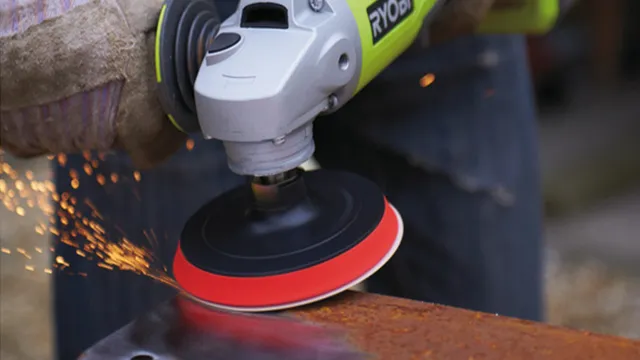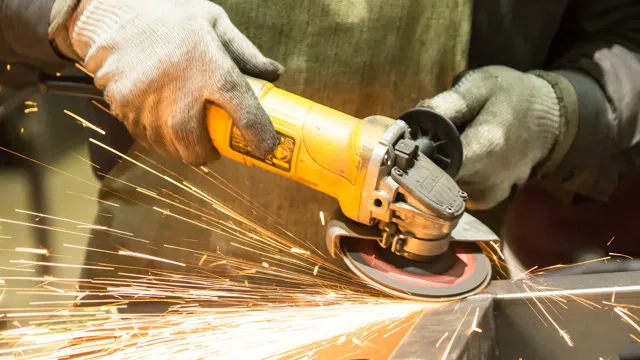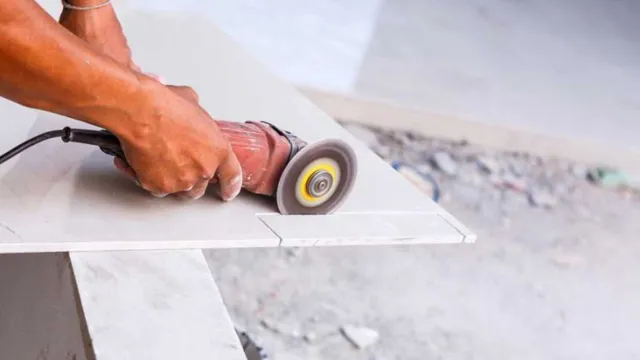What is an Angle Grinder Used for? A Beginner’s Guide to Understanding its Applications

Are you itching to upgrade your DIY skills or add a new power tool to your collection? Look no further than the angle grinder. This versatile tool can sand, grind, cut, and polish a variety of materials with ease, making it a must-have in any workshop. Picture a handheld disc sander with the power and flexibility to tackle tough metal or concrete, and you’ve got yourself an angle grinder.
Whether you’re a professional contractor or a DIY enthusiast, an angle grinder can revolutionize your crafting game. So, what exactly is an angle grinder, and how can you use it to your advantage? Let’s dive in and explore the ins and outs of this powerful tool.
Uses of an Angle Grinder
An angle grinder, also known as a disc grinder or side grinder, is a versatile tool that can be used for several purposes. One of the most common uses of an angle grinder is for cutting metal, wood, concrete, and other materials. With the right cutting disc attached, an angle grinder can cut through even the toughest of surfaces.
Additionally, an angle grinder can be used for grinding, sanding, and polishing. By using different attachments, it is possible to achieve different finishes on various materials. Another popular use of an angle grinder is for removing rust and paint from metal surfaces.
With a wire brush attachment, an angle grinder can easily strip away the old paint or rust from metal surfaces. Overall, an angle grinder is a handy tool to have in any workshop, as it can be used for various tasks ranging from simple to complex.
Cutting Metal
An angle grinder is a highly versatile and powerful tool that is handy for numerous cutting tasks, especially when it comes to cutting metal. It is an essential power tool in most workshops because of how efficient it is at cutting through tough metal, bolts, and even concrete blocks. With different types of blades and discs, an angle grinder can be used to cut through various metal thicknesses, widths, and lengths.
It is also useful for cleaning metal surfaces, cutting through rust, and removing stubborn paint. If you’re planning to do some home improvement and DIY projects that involve cutting metal, then an angle grinder is undoubtedly the tool you need to get the job done right. With a few precautionary measures, careful handling, and the right technique, you’ll become a pro at using an angle grinder in no time.

Grinding and Polishing
An angle grinder is a versatile tool that comes in handy when grinding and polishing various surfaces. It can be used for a wide range of tasks, including cutting, sanding, polishing, and cleaning. One of its main uses is for grinding metal and removing rust or paint from surfaces.
You can also use it to smooth out rough edges or to cut tiles and stone. If you’re in the construction business, an angle grinder is a must-have in your toolbox. It can also be used for sharpening tools or even creating intricate designs on metal surfaces.
With its powerful motor and interchangeable discs, an angle grinder is a reliable and efficient tool that can save you a lot of time and effort. Just make sure to follow safety guidelines, wear appropriate protective gear, and practice proper technique to prevent accidents from happening.
Tile and Concrete Cutting
Angle Grinder An angle grinder is a versatile tool that can be used for different purposes. One of its most common uses is for cutting tiles and concrete. Tiles can be hard to cut, especially if they are made of ceramic or porcelain.
Angle grinders make the job easier by cutting through both materials quickly and efficiently. Additionally, concrete can be challenging to cut, especially if you need to make precise cuts. An angle grinder features a rotating disc that can make the task much easier.
By using different types of blades, you can cut through stone, concrete, and other hard materials with ease. Just be sure to take safety precautions and wear protective gear, such as goggles and gloves, as well as a dust mask to avoid inhaling any harmful dust particles. Overall, an angle grinder is an essential tool if you’re planning on cutting tiles or concrete, particularly for DIY enthusiasts or professional contractors working in the construction or remodeling industry.
Types of Angle Grinders
An angle grinder is a versatile tool that is widely used in many industries. Its primary function is to grind, cut, and polish different materials, such as metal, stone, and concrete. There are various types of angle grinders that can be used for different purposes.
For example, small angle grinders are perfect for cutting tiles or sharpening garden tools, while large angle grinders are great for cutting and grinding thick metal sheets. In addition to this, there are also cordless angle grinders that run on batteries, which are easier to transport and ideal for use in remote areas. When choosing an angle grinder, it is essential to consider the disc size, motor power, and safety features.
Overall, an angle grinder is a powerful tool that can be used for a variety of tasks, making it an indispensable tool in the workshop.
Corded vs Cordless
When it comes to angle grinders, there are two main types to choose from: corded and cordless. Corded angle grinders, as the name suggests, require a power cord to be plugged into an outlet to operate. They tend to be more powerful and have a longer lifespan since they don’t rely on batteries.
On the other hand, cordless angle grinders are powered by batteries and are more portable, making them ideal for jobs where you need to move around frequently. However, they tend to have less power and a shorter runtime than their corded counterparts. Ultimately, the type of angle grinder you choose will depend on your specific needs and preferences.
Do you prioritize power and longevity, or do you need something that’s more mobile and convenient? Keep in mind that corded angle grinders are typically better for heavy-duty jobs and professional use, while cordless options are great for DIY enthusiasts and home use.
Size and Power
When it comes to angle grinders, there are two main types to consider: corded and cordless. Corded angle grinders are more powerful than cordless ones, making them ideal for heavy-duty jobs. They also come in a wider range of sizes, with larger models typically being reserved for industrial settings.
Cordless angle grinders, on the other hand, are often more lightweight and portable, making them perfect for DIY or home renovation projects. They come with rechargeable batteries, allowing you to work without being tethered to an electrical outlet. But keep in mind that cordless models may not be as powerful as their corded counterparts, so they may not be suitable for certain applications.
Ultimately, the choice between corded and cordless angle grinders comes down to the specific use and the level of power required.
Safety Tips When Using an Angle Grinder
Angle grinders are versatile tools used for cutting, grinding, and polishing different materials like metal, wood, and cement. They’re commonly used in construction and DIY projects, making it important to observe safety measures when using them. First, ensure that you’re using the right disc for the job.
Improper discs can cause accidents and damage the grinder. Secondly, always wear protective gear like goggles, gloves, and long-sleeved shirts to avoid flying debris and sparks. Thirdly, secure the material you’re working on with a clamp or vise to prevent it from moving around uncontrollably during operation.
Finally, never remove safety guards or handles on the angle grinder. These safeguards are put in place to protect you from injury, and disregarding them can lead to severe accidents. By following these safety tips, you can use an angle grinder with confidence and carry out your projects with safety in mind.
Wear Protective Gear
When it comes to using an angle grinder, safety should always be a top priority. One of the most important safety tips to keep in mind is to wear protective gear. This includes goggles or safety glasses to protect your eyes from flying debris, a dust mask to prevent inhalation of dust and particles, and gloves to protect your hands.
Additionally, it is recommended to wear long-sleeved clothing and sturdy shoes to protect your skin and feet. Remember, an angle grinder can be a powerful tool that should always be handled with caution. By wearing the appropriate protective gear, you can minimize the risk of injury and ensure that you are working safely.
Check the Tool Before Using
When it comes to using an angle grinder, safety should always be your top priority. Before you even begin to use the tool, it’s important to properly check it to ensure it is in good condition and that all components are secure. Make sure the grinder’s guard is attached, and inspect the cutting disc to ensure it is free from damage.
It’s also important to wear appropriate personal protective equipment, such as safety goggles, gloves, and a dust mask. Always keep the angle grinder firmly grasped with both hands and make smooth passes when making cuts. Not only will taking these safety precautions protect you from injury, but it will also help ensure the job is completed correctly and efficiently.
Remember, a small amount of preparation can go a long way in preventing accidents and injuries when using an angle grinder.
Conclusion
In conclusion, an angle grinder is not just a device for grinding angles – it’s a multi-purpose tool that can cut, sand, polish, and shape a variety of materials, from metal to concrete. Whether you’re a DIY enthusiast or a professional contractor, an angle grinder is a must-have tool in your arsenal. With its versatility and power, the angle grinder can take on any job and make it look like a piece of cake.
So, the next time you need to get something done, grab your angle grinder and get cracking – you never know what angles you might end up grinding!”
FAQs
What is an angle grinder used for?
An angle grinder is a versatile tool used for cutting, grinding, sanding, and polishing metal, concrete, and other materials.
What are the different types of angle grinders available in the market?
There are two main types of angle grinders available in the market- corded angle grinders and cordless angle grinders.
How do you choose the right angle grinder for your work?
You need to consider the size of the grinder, disc size, power output, speed, and safety features before choosing an angle grinder for your work.
Can angle grinders be used on wood?
Yes, angle grinders can be used on wood, but you need to use a specific grinding disc or sanding disc designed for wood.
What are the safety precautions to be taken while using an angle grinder?
Always wear safety goggles, gloves, and ear protection while using an angle grinder. Also, make sure to hold the grinder with both hands and keep the cord away from the grinding area.
How to maintain your angle grinder for longevity?
After every use, make sure to clean the grinder and replace worn-out discs. Also, store the grinder in a dry and cool place.
Can an angle grinder be used for cutting tiles?
Yes, an angle grinder can be used for cutting tiles, but you need to use a diamond-cutting blade designed for tiles.



